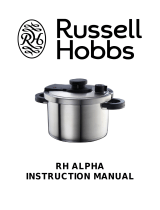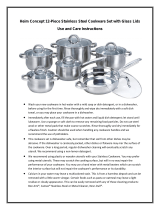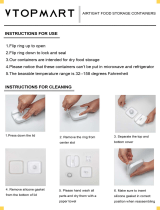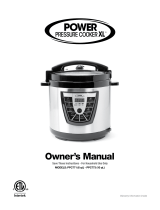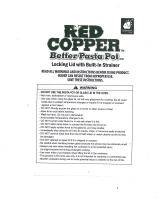Page is loading ...

INSTRUCTION BOOKLET
CPC22
For your safety and continued enjoyment of this product,
always read the instruction book carefully before using.
PRESSURE COOKER
PROFESSIONAL COLLECTION STAINLESS STEEL

2
TABLE OF CONTENTS
Important Safeguards . . . . . . . . . . . . . . . . . . . . . . . . . . . . . . . . . . . . . . . . . 3
Parts and Features . . . . . . . . . . . . . . . . . . . . . . . . . . . . . . . . . . . . . . . . . . . 4
Operating Instructions
Using the Pressure Cooker . . . . . . . . . . . . . . . . . . . . . . . . . . . . . . . . . . 5
Safety Features . . . . . . . . . . . . . . . . . . . . . . . . . . . . . . . . . . . . . . . . . . . . 6
Cleaning and Maintenance. . . . . . . . . . . . . . . . . . . . . . . . . . . . . . . . . . . 6
Pressure Cooker Helpful Tips and Tricks . . . . . . . . . . . . . . . . . . . . . . . . . 7
Troubleshooting. . . . . . . . . . . . . . . . . . . . . . . . . . . . . . . . . . . . . . . . . . . . . . 9
Warranty. . . . . . . . . . . . . . . . . . . . . . . . . . . . . . . . . . . . . . . . . . . . . . . . . . . 10
Product Registration . . . . . . . . . . . . . . . . . . . . . . . . . . . . . . . . . . . . . . . . . 11
0517
LISTED
SA44803

3
IMPORTANT SAFEGUARDS
READ AND SAVE THESE
INSTRUCTIONS
FOR HOUSEHOLD USE ONLY
When using a pressure cooker, basic safety precautions should always be taken, including the following:
1. READ ALL INSTRUCTIONS prior to use and refer
back to this user’s guide when needed.
2. Do not touch hot surfaces of pressure cooker. Use Cool Grip™ handles only. Use potholders
or oven mitts if necessary.
3. This pressure cooker should not be used by or near children or individuals with certain disabilities.
4. NEVER ATTEMPT TO OPEN LID WHILE THE UNIT IS OPERATING.
Do not open the pressure cooker until the unit has cooled and all internal pressure has been released.
If lid is difficult to rotate, this indicates that the cooker is still pressurized. Do not force it to open. Any
pressure in the cooker can be hazardous. See Operating Instructions, page 5.
5. Do not place the pressure cooker in a heated oven. FOR USE ONLY ON STOVETOP.
6. Extreme caution must be used when moving a pressure cooker containing hot liquids or foods.
7. Do not use the pressure cooker for other than it's intended use.
8. This vessel cooks under pressure. Improper use may result in scalding injury. Make certain unit is
properly closed before operating. See Operating Instructions, page 5.
9. Do not fill unit over ²⁄
³
full (MAXIMUM FILL LEVEL). When cooking foods that expand during cooking,
such as dried vegetables, do not fill the unit over ½ full. Overfilling may cause a risk of clogging the
pressure release valve and developing excess pressure. See Operating Instructions, page 5.
10. Be aware that certain foods, such as applesauce, cranberries, pearl barley, oatmeal and other cereals,
split peas, noodles, macaroni, rhubarb, or spaghetti can foam, froth and sputter, and clog the pressure
release devices. These foods should not be cooked in a pressure cooker.
11. Always check the pressure release devices for clogging before use (Pressure Release Valve, Red
Safety Valve and Silicone Sealing Gasket in lid).
12. Do not use this pressure cooker for pressure frying with oil.
13. When the desired pressure is reached, steam from the Pressure Release Valve will be visible.
Adjust the heat down to maintain a slow, steady release of steam. This ensures pressure is maintained,
but excess liquid does not evaporate. A slow stream of steam should always
be visible.
14. WARNING: USE EXTREME CAUTION WHEN RELEASING PRESSURE. Hot steam released from
Pressure Release Valve may result in injury. DO NOT LOOK OVER the Pressure Release Valve.
15. DO NOT TAMPER WITH LID. Do not tamper with lid or lid hardware. They are installed for your safety.

4
BEFORE FIRST USE
Remove any packing materials and promotional labels from your stovetop pressure cooker. Be
sure all parts are included. We recommend keeping the box and packing materials for use at a
later date. Before using your Cuisinart Professional Collection Stainless Steel Pressure Cooker
for the first time, make sure that the Pressure Release Valve is properly inserted within the
Pressure Regulator. To secure Pressure Release Valve, push valve into place until you hear a
click. Lift gently to ensure that it is attached. Remove any dust from shipping by wiping parts
with a damp cloth. Thoroughly clean the cooking pot in the dishwasher or with warm, soapy
water. Rinse, towel- or air-dry. Dry thoroughly before each use as moisture can build up under
the lid handle and can cause steam to escape as the pressure cooker heats up. This is not a
leak and the steam will eventually evaporate.
Lid Handle
Lid
Pressure Release Valve
Red Safety Valve Gasket
(underneath Red Safety Valve)
Pressure Regulator
Cool Grip
TM
Handles
Silicone Sealing Gasket
Induction Base
Lock/Unlock Settings
Cooking Pot
PARTS AND FEATURES
Red Safety Valve

5
OPERATING INSTRUCTIONS
Using the Pressure Cooker
1. Inspect lid to make sure it was properly cleaned. Any dirt or grease left on the lid from
previous use will alter the Pressure Release Valve.
2. Make sure to always have a timer ready for use.
3. To remove lid, grasp handle, turn clockwise and lift.
4. Add food and liquids as the recipe directs. NOTE: The total volume of food and liquid must
not exceed the MAX fill line (MAXIMUM CAPACITY) of the cooking pot. For foods such as
dried vegetables, or rice the total volume must not exceed ½ capacity. NOTE: Overfilling
may clog the Pressure Release Valve, which can cause excess pressure to develop.
Always use at least 1 cup liquid when pressure cooking for 10 minutes or less, or 2 cups of
liquid when cooking for more than 10 minutes; NEVER USE LESS.
5. If the Silicone Sealing Gasket has been removed from lid, check to ensure flexible ring is
securely in place on the metal plate. Press down firmly to secure, making sure that the edge
of the lid is aligned properly with the rim of the cooking pot.
6. To lock the lid in place, remove any food residue from upper rim of cooking pot to ensure a
proper seal. Place lid on pressure cooker and turn it counterclockwise into position.
7. Select a burner size that most closely matches the diameter of the bottom of the pot.
8. Slide the Pressure Regulator to the desired pressure level (High or Low). The Red Safety
Valve must be fully down to properly seal the pot before cooking.
NOTE: When placing lid on pressure cooker, the Pressure Release Valve should be facing away
from user.
WARNING: Hot steam released from Pressure Release Valve may result in injury if NOT
properly positioned.
9. Turn your heat source to high to build pressure. The Red Safety Valve will lift up to indicate
pressure is rising. The selected pressure (Low/High) has been achieved once the Red Safety
Valve has risen and there is a steady stream of steam from the Pressure Release Valve.
10. Pressure cooking will begin at this point. Reduce the heat source to maintain a slow, steady
stream of steam from the Pressure Release Valve. Make sure to start a timer at this point so
the food is properly cooked.
11. Adjust the heat source up or down to maintain only a slow, steady stream of steam from the
Pressure Release Valve.
12. The raised Red Safety Valve indicates you are cooking under pressure. The lid is double-
locked and cannot be opened. NEVER ATTEMPT TO OPEN THE LID WHILE PRESSURE
COOKING!
To Remove Lid
When your food has finished cooking, pressure must be released before opening the lid. WARNING: USE
EXTREME CAUTION WHEN RELEASING PRESSURE. (When releasing pressure, hot steam may
discharge from the Pressure Release Valve or Red Safety Valve.) When the Red Safety Valve is completely
down, turn the lid clockwise and lift to remove.

6
Two pressure release methods are available:
1. Slow release of pressure can be achieved by turning off the heat source and allowing the pressure
cooker to slowly cool.
2. Quick release of pressure is achieved by sliding the Pressure Regulator to the Quick Release setting
You may also use the pot without the lid to brown, sauté or sear prior to using the pressure settings.
Essential precautions – For browning, sautéing, and searing, we recommend using a low to medium
setting for most foods. To boil water, medium-high is sufficient. Never leave Cuisinart
®
Cookware or any
pan empty over a hot burner. Doing so can ruin the pan and cause damage to the stovetop.
Safe for all stovetops – The pressure cooker can be used on all stovetops (gas, electric, halogen,
ceramic, glass top and induction). Select a burner size that most closely matches the diameter of the
bottom of the pan.
Cooking on an induction burner – Please consult your induction stovetop manual for information on use.
Always center the cooking vessel over the burner for optimal performance.
Cooking over a gas burner – When cooking over a gas burner, make certain the flame touches only the
pan bottom. If the flame comes up the sides of the pan, energy is wasted and the sides of the pan may
become permanently discolored.
Safety Features
This Cuisinart
®
Professional Collection Pressure Cooker is equipped with safety devices installed in the lid
to assure its reliability. If the lid is not placed on the vessel correctly, it will not begin to hold the pressure.
1. Pressure Release Valve – Releases excess steam once desired pressure is achieved.
2. Red Safety Valve – Safely locks lid when pressure cooker is in use.
3. Safety Window – If Pressure Regulator and Red Safety Valve are malfunctioning, the steam will release
from the Safety Window.
4. Opening Lid Handle – Pressure must be released prior to removing the lid.
Cleaning and Maintenance
1. Cooking pot is dishwasher safe. To hand-clean the pot, fill the pot with hot water and liquid dish
detergent; let stand until lukewarm. Use a sponge or soft cloth to remove any remaining food particles.
Steel wool or other metal pads that are coarse will scratch the surface. Rinse thoroughly and dry
immediately for a flawless finish. Caution should be used when handling any cookware handles. We
recommend the use of potholders or oven mitts. Be careful not to damage the inside cooking surface.
Never use harsh chemicals or scouring pads.
NOTE: The pressure cooker pot is dishwasher safe, but remember that soil from other dishes may be
abrasive. If the dishwasher is carelessly packed, other dishes or flatware may mar the surface of the
cookware. Over a long period, regular dishwasher cleaning will eventually scratch any utensil. We
recommend using a non-lemon detergent.
The Cuisinart
®
Professional Collection Pressure Cooker lid is NOT dishwasher safe.
(See below for further cleaning instructions).
2. Remove the Sealing Gasket from the inside of the lid by grasping the lid handle and pulling out the
gasket. Set aside.
3. Remove the Pressure Release Valve from the lid by gripping and pulling firmly upward.
Rinse with warm water, and dry.

7
4. Thoroughly rinse the lid with warm water, making sure that the Pressure Release Valve and the Red
Safety Valve are free of residue. Dry completely, and replace Pressure Release Valve. (Dry thoroughly
before each use as moisture can build up under the lid handle and can cause steam to escape as the
pressure cooker heats up. This is not a leak and the steam will eventually evaporate.)
5. To clean Sealing Gasket, carefully remove and clean in dishwasher or with warm soapy water. Do not
use chemical cleaners.
6. Replace Sealing Gasket in lid when dry.
What about metal utensils? We recommend using plastic or wooden utensils with your Cuisinart
®
Professional Collection Stainless Steel Pressure Cooker. You may prefer using metal utensils. These may
scratch the cooking surface, but will in no way impair the performance of your Cuisinart
®
Professional
Collection Stainless Steel Pressure Cooker. You may use a hand mixer with metal beaters which can
scratch the interior surface, but will not impair the cookware’s performance or its durability.
To remove stains – Calcium in your water may leave a multicolored stain. This is from a harmless deposit
and can be removed with a little warm vinegar. Certain foods such as pasta or oatmeal may leave a light
residue or cloudy appearance. This can be easily removed with any nonabrasive cleaning product.
CAUTION: Detergent fumes can be irritating. Carry out the following procedure under a hood with an
exhaust fan or in a well-ventilated room.
To remove burner stains – Stains on the outside bottom (not sides) of the pot can be removed with an
oven cleaner. Follow the manufacturer’s directions and spray or brush the cleaner on only the outside
bottom of the pot. If the directions call for using the cleaner in a warm oven, heat the pot before applying
the cleaner. Rinse thoroughly after cleaning.
IMPORTANT NOTE: Your Cuisinart
®
Pressure Cooker has exceptionally high thermoconductivity, and even
a low setting on some gas burners can overheat or even burn foods, such as thinly sliced onions. An
inexpensive gas “flame-tamer” placed between the burner and the bottom of the pot solves this problem.
Flame-tamers are readily available at most hardware and kitchen stores.
PRESSURE COOKER HELPFUL TIPS & TRICKS
1. Always use at least 1 cup of cooking liquid. For longer cooking times, additional liquid, at least 1 to 2
cups is necessary.
2. Never fill the pot more than ²⁄
³
full, to the maximum fill level. When cooking foods that expand (like rice,
etc.), do not fill unit over ½ full.
3. Always wait until pressure is completely released before attempting to remove the lid. The Red Safety
Valve needs to fully drop to ensure all pressure is released.
4. Use caution when removing the lid. Lift lid away from you and allow any condensation to drip out
before resting on the counter upside down.
5. Unit reaches full pressure when Red Safety Valve pops up and steam releases continuously from the
Pressure Release Valve. Regulate pressure by reducing temperature to medium/medium-low to
maintain full pressure. There should be slight steam and consistent hissing from the Pressure Release
Valve. Make sure to start timing (the pressure cooking time) ONLY after steam from the Pressure
Release Valve is visible and steady.
6. Keep a close eye on the pressure cooker when cooking. Some adjustment of temperature may be
necessary to maintain pressure.
7. Have a timer close by when pressure cooking.
8. Most conventional recipes can be converted to use the pressure cooker. In general, cooking time will
be reduced up to 70% of the traditional cooking time.*

8
9. Quick pressure release can be done by sliding the Pressure Regulator to Quick Steam Release or by
letting the pressure come down naturally. Natural pressure release is typical for slow-cooked foods that
can benefit from maximum cooking time; simply remove pot from heat until Red Safety Valve drops.
10. When releasing pressure using the quick pressure release method by sliding the Pressure Regulator,
be sure your hand is clear of the Pressure Release Valve.
11. Cooking times vary. Always err on the side of shorter cooking time, as food can always be brought
back to pressure if not cooked enough, rather than being overcooked.
12. Most foods are cooked with High pressure. Those foods requiring a more gentle cooking method, like
some rice, vegetables, seafood and eggs, are best cooked using Low pressure.
13. The pressure cooker pot has excellent heat retention properties and browns well. You can brown, sauté
or season foods first without the lid for extra flavor. Start with a lower heat than you normally would use
to brown and sauté.
14. Browning adds depth of flavor to the dish and can be done right in the pot. However, this step is not
always necessary if you’re short on time.
15. Larger cuts of meat cook more efficiently and evenly when cut into pieces.
16. If after pressure cooking, food is still undercooked, cook under pressure in 1- to 5-minute increments.
17. Cooking in higher altitudes requires longer cooking times. For every 1,000 feet above the first 2,000
feet, increase cooking time by five percent.
18. When cleaning, please note that only the cooking pot is dishwasher safe. The lid and gasket can be
cleaned by hand-washing in warm, soapy water.
19. For easy storage, the lid can be placed upside down on top of the pot. It is important to keep all parts
of the pressure cooker together when not in use.
*Always follow recipe instructions and pay close attention to appropriate cooking times.

9
PROBLEM REASON SOLUTION
Lid does not lock. The Silicone Sealing Gasket is not
properly installed in the lid.
Remove the Silicone Sealing
Gasket and re-install as
instructed on page 5 of the
instruction booklet.
The Red Safety Valve is not rising.
1. The Pressure Release Valve is
not placed properly.
2. There is not enough liquid in
the cooking pot.
3. Air is escaping from the rim of
the lid or Red Safety Valve.
1. Remove and re-insert the
Pressure Release Valve. See
Cleaning and Maintenance,
No. 3, pg. 7.
2. Check recipe for liquid capacity
(must be at least 1 cup).
3. Check the placement of the
Silicone Sealing Gasket and
Red Safety Valve Gasket.
Steam escapes from the
underside of the lid.
1. Silicone Sealing Gasket is not
properly aligned.
2. Silicone Sealing Gasket is dirty.
1. Clean the Silicone Sealing
Gasket, cooking pot rim,
and lid.
2. Replace the Silicone
Sealing Gasket.
3. Remove the Silicone
Sealing Gasket and re-install
as instructed on page 5 of the
information booklet.
Steam and liquid leaks from the
Red Safety Valve.
The Pressure Release Valve is
obstructed.
Take the cooker off of the stove.
Once it is cool, remove the
Pressure Release Valve and clean
to remove the obstruction.
Lid does not fi t properly.
1. The lid is not aligned properly
with the cooking pot.
2. The Silicone Sealing Gasket is
not properly aligned.
1. Replace the lid of the pressure
cooker.
2. Remove lid and re-attach
as instructed on pg. 6 of the
instruction booklet.
3. Re-align the Silicone
Sealing Gasket.
When cooking, the Silicone
Sealing Gasket is suddenly
protruding out from the Safety
Window.
The Red Safety Valve or Pressure
Release Valve is obstructed.
Remove the cooker off heat.
Once cooled, clean and check all
the components.
Lid does not open after all
pressure has been released.
1. The Red Safety Valve is still up.
2. Lid was turned to unlock before
all pressure was released.
1. Slide the Pressure Regulator
to the Quick Release setting.
Ensure all pressure is released
and Red Safety Valve should
drop.
2. Turn lid clockwise to unlock
position and remove the lid.
TROUBLESHOOTING

10
LIFETIME WARRANTY (U.S. and Canada Only)
Your Cuisinart
®
Professional Collection Stainless Steel Pressure Cooker is warranted to be free
of defects in material and workmanship under normal home use from the date of original
purchase throughout the original purchaser’s lifetime. If your pressure cooker should prove to
be defective within your lifetime, we will repair it (or, if we think it necessary, replace it) without
charge to you, except for shipping and handling. To obtain warranty service, please call our
Consumer Service Center toll-free at 1-800-726-0190, or write to Consumer Service Center,
Cuisinart, 150 Milford Road, East Windsor, NJ 08520. To facilitate the speed and accuracy of
your return, please also enclose $7.00 for shipping and handling of the product. Please also be
sure to include a return address, description of the product problem, phone number, and any
other information pertinent to the product’s return. Please pay by check or money order made
payable to Cuisinart.
This warranty excludes damage caused by accident, misuse or abuse, including damage
caused by overheating, and it does not apply to scratches, stains, discoloration or other
damage to external or internal surfaces which does not impair the functional utility of the
cookware. This warranty also expressly excludes all incidental or consequential damages.
Some states do not allow the exclusion or limitation of incidental or consequential damages, so
the foregoing limitation or exclusion may not apply to you. This warranty gives you specific legal
rights, and you may also have other rights which vary from state to state.
CALIFORNIA RESIDENTS ONLY
California residents need only supply proof of purchase and should call 1-800-726-0190 for
shipping instructions. California law provides that for In-Warranty Service, California residents
have the option of returning a nonconforming product (a) to the store where it was purchased or
(b) to another retail store which sells Cuisinart products of the same type. The retail store shall
then, according to its preference, either repair the product, refer the consumer to an
independent repair facility, replace the product, or refund the purchase price less the amount
directly attributable to the consumer’s prior usage of the product. If the above two options do
not result in the appropriate relief to the consumer, the consumer may then take the product to
an independent repair facility if service or repair can be economically accomplished. Cuisinart,
and not the consumer, will be responsible for the reasonable cost of such service, repair,
replacement or refund for nonconforming products under warranty. California residents may
also, according to their preference, return nonconforming products directly to Cuisinart for
repair, or if necessary, replacement, by calling our Consumer Service Center toll-free at 1-800-
726- 0190. Cuisinart will be responsible for the cost of the repair, replacement, and shipping
and handling for such nonconforming products under warranty.

11
REGISTER YOUR PRODUCT NOW!
Complete the two easy steps to register your product and receive
premium customer service, special offers and more!
Take a photo of your Photoregister Code below including the points
STEP 1
TAKE A PHOTO

12
SMARTPHONE US/CANADA
Text photo to 71403
EMAIL WORLDWIDE
cuisinart@photoregister.com
ONLINE WORLDWIDE
register.cuisinart.com
STEP 2
SEND IT IN
OR
OR
Need help? Visit Photoregister.com/help or text HELP to 71403.
W-9/026-ESP-C
©2017 Cuisinart
150 Milford Road, East Windsor, NJ 08520
Printed in China
17CW025696
IB-14121
/
